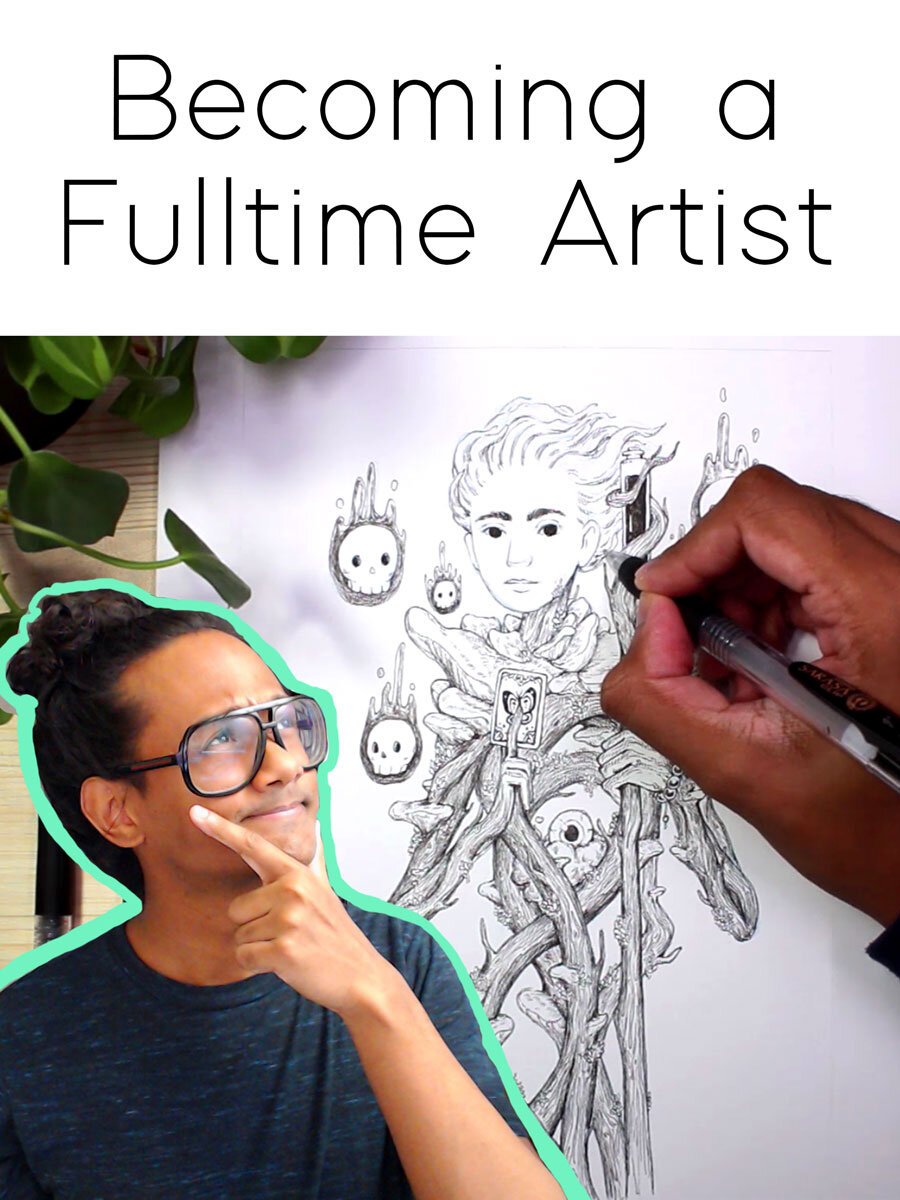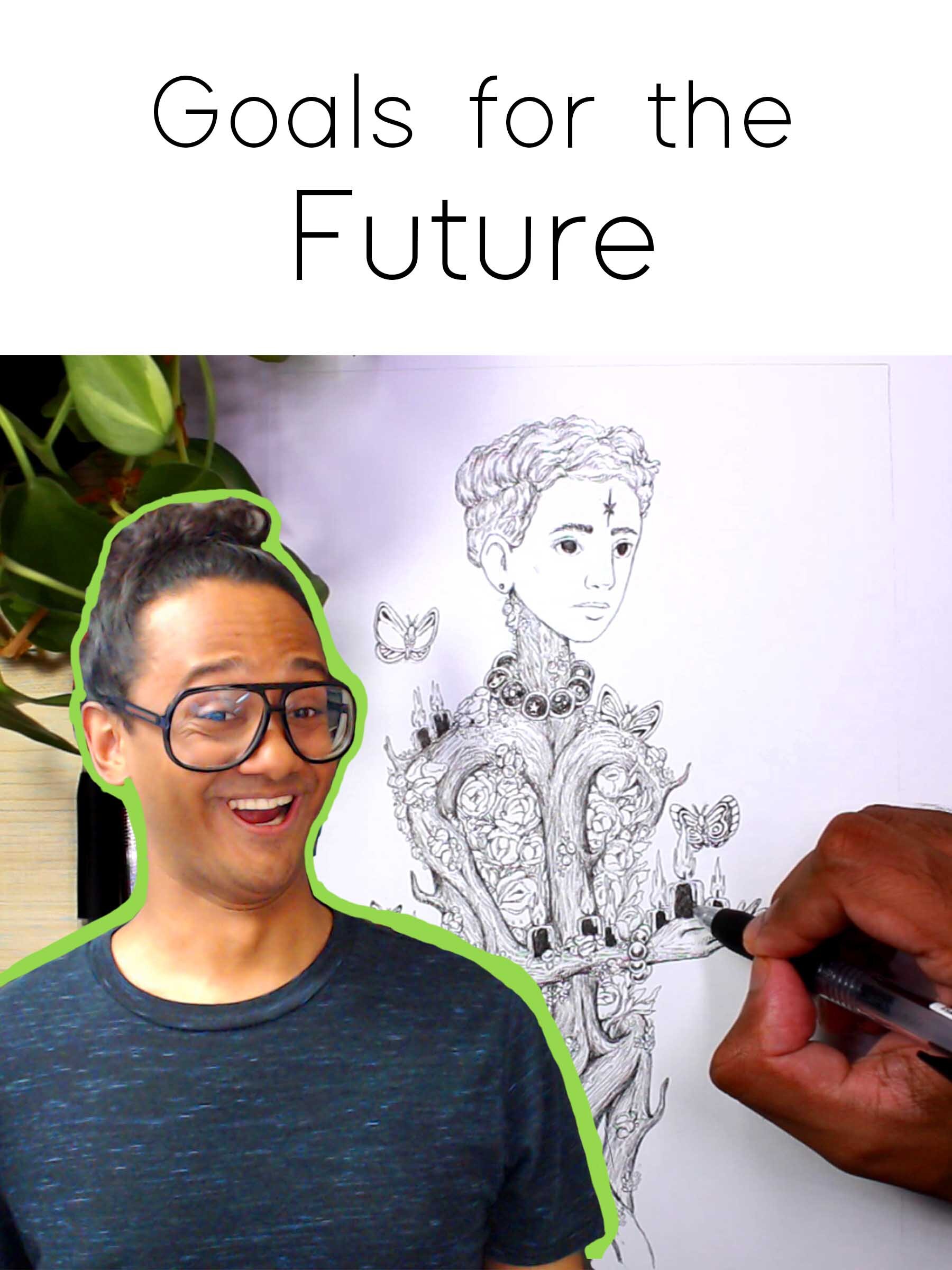Making Money as an Artist Online
In today's blog & video, I will be going over the core business model that independent artists use and also my plans for the future. There are parts of this model that are specific to me but the central core is something most artists can do and has been proven very effective for many independent artists online.
Making money is usually a hard topic to discuss but it is my goal to show how it's possible and therefore I will be very transparent with my journey as an artist.
Make Art
The most important part of all this is to remember that making art is the highest priority at all times. The whole reason we are discussing the topic of making money is so we can make the art we want. I think its really important to already have the discipline of creating work consistently before approaching the topic of money because it’s much easier if you have the work in place.
Making a lot of art will not only give you more to sell, but it also gives you content to do marketing with. People love projects that have enough content that they can sink their teeth into, its the difference between a youtube channel that has tons of videos that you enjoy and one that only has a few. Quality is important but you have to have enough quantity so that it feels like a full project.
This first step is probably one of the harder steps because it means that you have to continuously cultivate your love for the art-making process and not forget why you do it.
Originals
Selling originals is by far one of the easiest ways to make money as an artist because the value of an original item is very clear. It is understood that something that is handcrafted is of higher value than something that is mass-produced. I work in traditional mediums so this comes naturally from the process of making art.
If you are a digital artist you can create similar high-value items by offering 1-5 hand-embellished prints that are sold at similar rates.
My goal is to get the sales of originals to cover all my expenses. I can create about 12-16 original drawings per month and my expenses are at about $1300/month. This means that if I sell my work at $100 I can cover most of or all of my costs just through original sales.
Prints
Prints are a great way to sell work at scale. Scalability is a huge part of making a sustainable business, it means that you can sell a piece of work multiple times without a lot of extra work. The downside of originals is that you only have one, but with prints you can sell an unlimited amount of copies.
Artists such as James Jean have spoken about selling 1000-2000 copies of a single print, which would be $20,000- $40,000 in profit if his profit margin was $20. This might seem out of reach for a starting artist but I believe it is something anyone could build up towards. If you plan on making art for the rest of your life you want a business model that can fully utilize the size of your audience as it grows.
One of the keys to selling prints online is to have limits on either the quantity or the time within which the print is available. Artists like Pete Mohrbacher uses limited edition prints where he only sells a set number of each print. The reason this becomes necessary is that if the prints are always available, customers have no reason to buy right now. Procrastination is not a problem that is exclusive to boring school projects, it can also be found in eCommerce.
I will be using a print on demand service, Printful to be exact, to do all the printing and shipping for me. This means that I have more time to spend on making art, which is my entire focus through this process. Because I don’t have to do the fulfillment of the products myself, I have set prints to be limited based on time rather than copies. If you are planning to do fulfillment yourself, it might make more sense to limit the number of copies so you won’t suddenly have to ship out tons of packages if a print becomes popular.
Using Print on Demand services does eat into profits, but you have to weigh that cost against the time it would take away from creating art. I am currently in the mode of growing my body of work as quickly as possible, so for me, the lost profit is of no concern. I also low monthly expenses so this isn’t as big of a deal if you have people relying on you for financial support you might find that its worth the extra time to make more money.
Patreon
Patronage of the arts used to be something that was exclusive to the rich but now artists are being supported directly through Patreon. This marks a shift in our culture where fans are willing to support the creators they care about because the personal connection that is created through the work is worth the money. The value exchange between patrons and creators is confusing to a lot of people because it’s not a clear one to one transaction.
When someone pledges to a patreon, they arent being sold on the product as much as they believe in the larger vision. Audience members are savvy enough to understand that people who create need support, so if they get work for free that is of value they are willing to pay for it to continue.
Providing a bit of exclusive content that a hardcore fan would love is a great way to create a small incentive to pledge. I will be using exclusive sketchbook pages as my patreon reward, this makes a lot of sense because only the ones that are really invested in the project will want to see more of what happens behind the scenes. If you are considering patreon, make sure to lean towards something that is digital. Digital content scales so you wont have to spend time shipping and packing.
Digital Sketchbook
I have considered and will probably try to put up a digital eBook of my sketches to see if there is interest for the sketchbook work outside of the patreon.
Digital products is where most financially successful artists tend to make money, look at how popular tutorials are and this becomes pretty obvious. Digital content is very easy to publish and there are no extra costs involved beyond its creation. So if you create a digital product for $15 and sell 20 copies per month for 10 years, you will have made $36,000 off a single digital product.
Digital scaling can be a key component to an art business but I personally don’t want to make my money off other artists. I want to be able to stand as a role model for what is possible outside of art education as a main source of income. I dont think there is anything wrong with selling tutorials but I just wouldn’t feel good about selling to other artists.
Art Book
The ultimate goal of this project is to have artbooks made. Artbooks are great because they are a lowered barrier to entry for the customer. Prints and originals requires the customer to actually take the time to frame and hang the work while an artbook can easily be put on a coffee table or bookshelf.
Originals and Prints are great for short term monetization but art books is something you can keep selling into the future. The biggest hurdle for art books is that you need both a large body of work and also a decent size audience. My approach is that I want to grow the audience to a large enough size that publishers will approach me. I want to have the leverage so that I can get a decent contract.
You can self publish books, which many artists have done through Kickstarter but this doesn’t seem like a viable option for me because I just want to focus my time on making more art.
Other Merch.
There are plenty of other merchandising that can be done with artwork, pretty much everything has designs on them and with Print on Demand companies, you can find some really crazy stuff (like beanbag chairs with your design on it).
The main two things that I am considering are enamel pins and hoodies because I think they are very useful items that I myself would enjoy. The reason these things are separated in the diagram is that they would require designs that specific and outside my normal art-making process.
Enamel pins are especially attractive to customers because they can collect many without taking up large space and they are also really easy to ship. Pins are also great for Patreon Pledge Drives which is a topic that we will cover when I get around to doing one myself and have more experience on the topic.
Youtube + Blog
So this portion is more specific to my circumstances but I wanted to share some of my thoughts. Through this blog I will be covering topics that are of deep interest to myself and I will be sharing things that I believe in. This opens the opportunity for me to share resources that can have some financial kickback to my business.
I will be talking a lot about books that I have read and I will be recommending them because my entire life philosophy comes from books. I will be using affiliate links for these books so I get a very small commission every time someone uses the links. This obviously wont become a huge source of income but its something that might be able to cover the cost of a few coffees.
The second source I am considering are sponsorships like Squarespace. I am uncertain if they would have any interest in sponsoring the channel but I will be doing videos on setting up a great website and I honestly believe so strongly in Squarespace as a platform. I think investing in a good website that will last the test of time will be the foundation for any online business. This becomes especially true for artists that want to spend their time creating instead of wasting time coding.
I would love it if a sponsorship ended up covering the costs of upgrading equipment for the channel and allowing me to build greater resources for other creators.
Conventions
Last off I wanted to mention that conventions are by far one of the best ways for an artist to develop a deep connection with an audience while making money. Talking to people face to face about your work leaves a lasting impression that is difficult to develop online. I personally wont be doing any in the short term because my main focus is building my body of artwork, but I highly recommend you consider doing them if you are an artist that is looking to make money.
Most Importantly
Remember that this is about making the art, I know I have said it plenty of times throughout this post but the financial freedom should be born out of the creativity of the work. We want to make sure that we create art that is meaningful and honest. You don’t have to compromise on your creativity if you use the right Business Model. If you are trying to become an independent artist consider staying in touch through the mailing list or subscribing on youtube, I will be making many more resources for independent creators on how to run an effective business.



